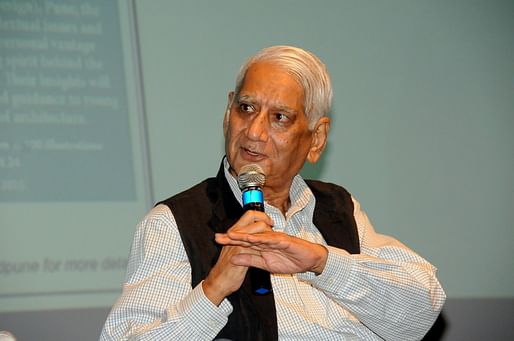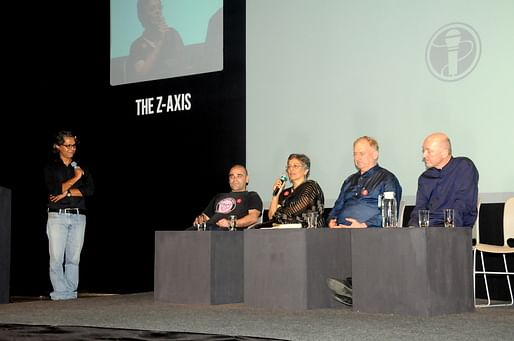
India is currently the second most populated country in the world, closely following China, at 1.25 billion people. Around 30 percent of its inhabitants, roughly the population of the entire United States, live in urban areas that continue to grow. The astonishing numbers are proof of the country’s demographic explosion, and make Indian cities a fascinating combination of chaos and vitality rarely found elsewhere. Great City…Terrible Place, this year’s Z-AXIS symposium curated by the Charles Correa Foundation in Goa, explored the complex forces shaping global cities in an effort to understand the dynamism of India’s ever-changing urban centers. Held over three days at Kala Academy, one of Correa’s masterworks, the conference brought together speakers from different corners of the world to share their views with an audience eager to take an active role in India’s urban transformation.
The conference’s moderator, Pratyush Shankar, described cities as places of will, where people forge new identities. However, as he suggested in his opening speech, cities can also be understood as artificial environments (the city as a machine) and as civilizational symbols (the city as a cultural narrative). The role of architecture and urban design must therefore reflect the vibrancy of cities, not just shaping the physical realm but also regenerating the deeper tissues of cultural and economic manifestations.

Synergy, Charles Correa sustains, is a vital quality of a city; and certainly the most important characteristic of any Indian city. It explains not only why the migrant goes from the village to the city, but more importantly why, once the move is made, he cannot go back to the village. With this in mind, cities like Mumbai (formerly Bombay) and Kolkata (formerly Calcutta) were the focus of the conference. They are by no means beautiful cities, appearing disorderly and haphazard to the foreign eye. However, as Santiago Cirugeda said later on in the afternoon “all of us [architects] think of [cities] as beautiful or ugly; very few of us talk about the conditions [they respond] to.”
Correa stated in his essay, Great City Terrible Place, that “criminal indifference to cities like Calcutta or Bombay over the last decades have allowed conditions to deteriorate to sub-human levels... While [Bombay] is getting better and better as a city, [it is] disintegrating (very rapidly and quite unnecessarily) as environment… [P]erhaps what [it is] experiencing is the last burst of energy… the spastic twitches before the end.” At the same time that it is “a place of unique opportunity, with truly mythic dimensions,” its intensity might accelerate its demise.

Throughout three days of lectures, panels, and informal discussions, attendees and guests explored different ways in which to address the challenges posed by India’s unprecedented urbanization. Spanish architect Rafael Moneo’s very formalistic lecture on the qualities of architecture contrasted with Urban-Think Tank founder Alfredo Brillembourg’s views on scarcity as a driver of design. Similarly, architect Brinda Somaya’s patient approach to her work enriched Santiago Cirugeda’s urgency to reclaim the citizens’ position in their own city. Yet despite the different approaches and diverse geographies, the recurring theme involved an understanding of architecture as a vehicle for change.
Architecture revolves around process and, as Correa maintains, its success lies in balancing economic systems and political forces. Architect Ton Venhoeven talked about the city’s inputs and outputs as part of a circular economy. While he suggested the vision of the city as a machine, he stressed that “smart cities [can only be] successful if they can ultimately be vibrant and happy”. Kunlé Adeyemi (of OMA), quoting Medellin’s former mayor Sergio Fajardo, proposed that “our most beautiful buildings should be in our poorest areas.” In his view, beauty is part of a broader process of transformation as opposed to fulfilling its more obvious aesthetic purposes. Christopher Benninger, architect and planner, set the architect forth as an enabler rather than a prescriber, showing work that integrated local traditions into the functions of modern civilization. Simone Sfriso of Venice spoke of integration and inclusion through the lens of sustainability, and Brinda Somaya summed up the general tone of the conversation by placing the architect as a catalyst for urban transformation.


The speakers’ approaches varied in scope: from culturally sensible, to proactive (either through government or at the hands of private organizations), to subversive. Benninger heightened the importance of making buildings that people can recognize as their own, whilst Somaya highlighted the value of defining a collective urban memory. Venhoeven addressed the issue of designing for the poor, and others like Adeyemi and Brillembourg approached architecture from the perspective of holistic development. Cirugeda set a clear stance, and vehemently insisted on reestablishing the citizen’s relationship with urban governance. From passive to militant all presentations pushed the limits of controversy, supported by an audience eager to get involved.

Great City… Terrible Place engaged students and professionals in intellectual discussions that will undoubtedly shape the urban future of India. Audience reactions ranged from inquiring about the role of design in the beautification of Indian cities, to very specific questions (and almost denunciations) on topics such as the impact of increased density along the Pune metro corridor, a proposed rail project in the Indian city. Summing up the conference, Brillembourg stated, “architecture parts from theory, [from] a hypothesis… without theory there is no backing for a building.” Urban development must revolve around process, enhancing the synergies that make cities thrive. Aesthetic beauty, rather than an objective, must come as a result of urban vibrancy. Indian cities today may not be stunning, but sure enough they are fascinating places of opportunity and cultural exchange. The challenge then is to reconcile a Great City to make it a Beautiful Place. As Santiago Cirugeda rightly said, “if you identify the functionality, beauty will come with time.”
No Comments
Block this user
Are you sure you want to block this user and hide all related comments throughout the site?
Archinect
This is your first comment on Archinect. Your comment will be visible once approved.